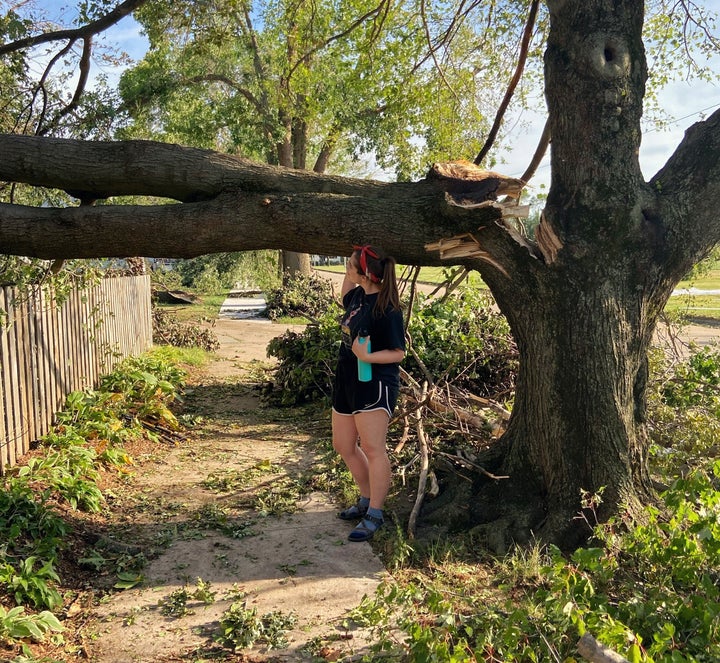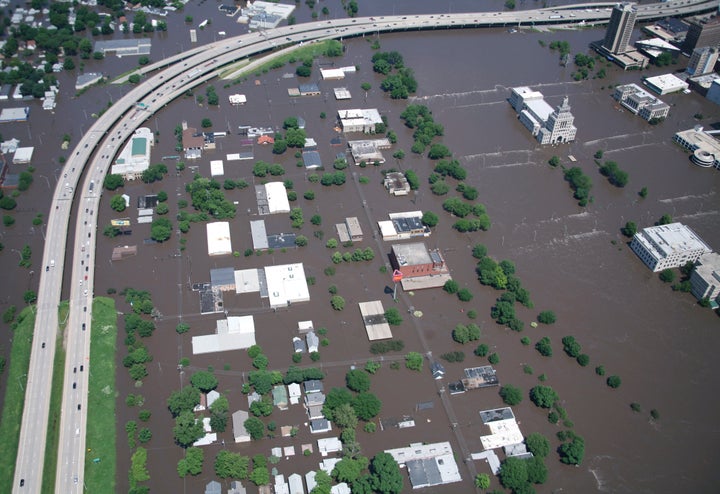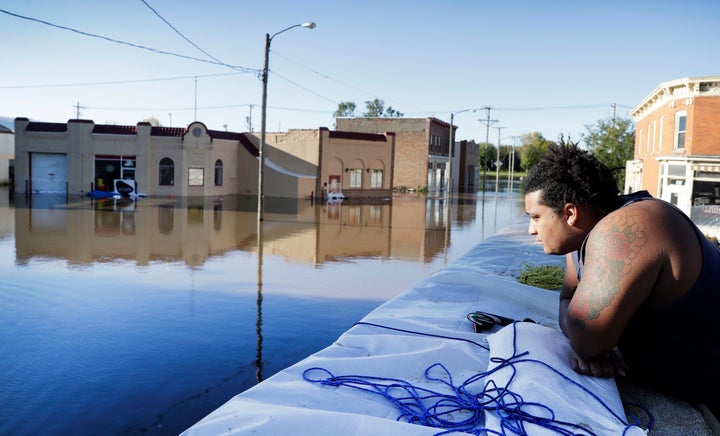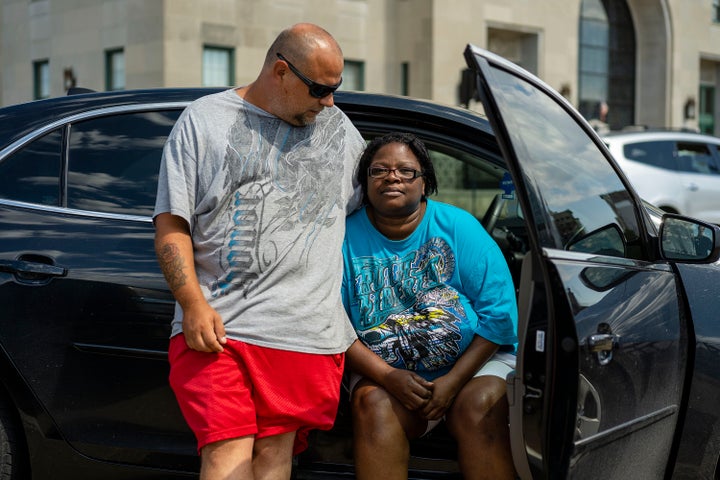
My house stands on a neighborhood corner in Cedar Rapids, Iowa. It’s been here for 100 years. My husband and I are only the third family to own this house, but the original land was inhabited by people from the Sac and Fox Nation. This community nestled by the Cedar River has been home to people for centuries.
But in 2008, Cedar Rapids was completely underwater, and so was this house. The river crested at over 31 feet. The National Guard arrived in helicopters to evacuate residents in the middle of the night. It took weeks for the floodwater to go down and for power and plumbing to be restored. In the aftermath, whole neighborhoods were completely wiped out and deemed uninhabitable. The flood of 2008 was considered one of the worst natural disasters the United States had ever seen.
This house was one of the lucky ones, and the family who owned it before us restored it and moved back in. Over time, our nearby Main Street was rebuilt. It took about six years, but eventually our city got back on its feet.
We’re told that one day a permanent floodwall shielding the city will keep the water in the Cedar River’s banks. After a decadelong battle for federal funding, a full flood control system for Cedar Rapids is projected to be completed by 2034.

My husband and I bought this house in 2015. We love the original woodwork, the big backyard and its towering trees. But in September 2016, the house and the city of Cedar Rapids almost went completely underwater again.
This time the community knew what deep water could look like. Troops arrived early to build an emergency natural berm to fortify the riverbank. Citizens sandbagged every building that flooded back in 2008. We refused to lose it all a second time.
We worked through the nights stacking sandbags. We emptied out the businesses on the Main Street. We carried every single book out of my favorite little bookstore and cleared basements for blocks and blocks in a matter of days. There was just so much to save.
We ate all the food in our fridges as we prepared to lose power. We braced ourselves.
The day came when the National Guard issued an evacuation order, the second time in less than a decade. Uniformed troops set up camp in our front yard, monitoring the perimeter of the flood zone. If your house was in the flood zone, they told you to leave town.
My husband and I packed a bag and left. I will never forget how orange and pink and purple the sunset was the night we drove away from Cedar Rapids.
That next week, I watched the river rise every morning from drone camera footage streaming on Facebook Live. I scanned the grainy feed for a glimpse of my house. The river rose to its second-highest recorded level, but the emergency berm held a lot of the water back. There was some damage to businesses closest to the river, but my house and much of the neighborhood stayed dry. Within a week the evacuation order was lifted, power restored, and the community began to slowly reopen.

So why write about the flooding now, after four years have gone by? Because on Aug. 10, our city was hit with its third “once in a lifetime” climate disaster in just 12 years. We were pummeled by a Category 4 windstorm called a derecho ― or sometimes a “land hurricane.” The winds blew 140 mph.
This time there was no warning. My husband was out on a bike ride. One minute I was working from our home office, and the next minute the sky went dark as night. I looked to my right and saw a tree — the little oak I planted on the first Earth Day we lived in this house — lift and fly right out of the ground, zipping horizontally through the air like an arrow.
I grabbed my cat and dog and we took cover in the basement. Upstairs the whole house shook violently. I heard breaking glass and rattling doors. There was crash after crash as trees fell. I wasn’t sure if the house above my head would still be there when we came above ground. I didn’t know if my husband would be safe or not. I threw up down the front of my shirt.
When we finally came above ground again, all I heard was emergency sirens. There were power lines down on every block. Power lines down in my backyard. People running everywhere. A massive gridlock of cars on our usually quiet neighborhood street. Every major tree was blasted to pieces. I saw trees on houses, trees on cars.
Inside our house, a window had shattered and a whole door blew in. I still had puke on my shirt, but I put on a pair of gloves and started to pick up the glass. I got a text from my husband. He was safe. The next morning, we heard that another cyclist didn’t make it home from the storm.
“We are one of the richest countries in the world, and this week I met fellow Iowans who were sleeping in buildings that looked like a bomb had destroyed them.”
Our community remains in crisis. There are 75 square miles of devastating damage to homes and businesses. Thirty-four schools suffered damage, and all Cedar Rapids Community Schools are closed until Sept. 21. A quarter of a million people went without power for over a week during a pandemic. So much food rotted in fridges. Some people couldn’t plug in their oxygen tanks.
We have seen incredible grassroots efforts to provide aid. There are people dragging coolers door-to-door carrying ice, water and fruit. There are citizen-led food banks and cookouts and relief efforts. But it’s not enough, and we’re relying too heavily on the people with the fewest resources to provide crucial aid, rather than demanding that support from the government.
We are one of the richest countries in the world, and this week I met fellow Iowans who were sleeping in buildings that looked like a bomb had destroyed them, not sure where their next meal would come from.
As the Democratic National Convention started, I was trying to organize a food drive for 150 of my neighbors who didn’t know how they would eat the next day, all while sleeping in a tent in my backyard without power or the internet. There is a lot going on in our country, and I want to care about things like the election and the stripping of the U.S. Postal Service, and even the warming of the planet that caused this mess. And in my normally quite privileged life, I think about these concerns a lot.
But that night, the twin devils of the climate emergency and public austerity measures had caused real, urgent, human problems for my neighbors, and all I could think about is how to get them fed.

The climate emergency is not something in our future; it is something that it is upon us right now. After every disaster, I’m sure this will be “the one” where our voices are heard, where people in power will actually help. Every time I am disappointed.
City leaders were slow to call in the National Guard. It took Gov. Kim Reynolds six days to send in the disaster declaration paperwork, rather than submitting a faster abbreviated request, as she compiled a preliminary damage assessment. All the while Linn County residents were without power or completely unhoused.
President Donald Trump visited Cedar Rapids for a few hours eight days after the storm hit. He did not leave the Eastern Iowa Airport. He initially approved only $45 million of the $4.99 billion requested in Federal Emergency Management Agency funding for our state, which did not include aid for those whose homes were destroyed or for the damage to farms. On Aug. 20, he approved additional relief for Linn County but all the other FEMA requests are still being assessed.
It’s unacceptable. I want my elected officials to respond to the climate crisis with the energy and compassion that our volunteers, grassroots organizers and nonprofits do. I want elected officials to take care of our communities as urgently as the people dragging coolers down the street, the neighbors who won’t sleep until they’re sure others have something to eat tonight.
“If we mobilize now ... maybe we can build a society that doesn’t crumble when the storms inevitably come.”
As well as demanding meaningful government help to get communities scarred by climate disasters back on their feet, we need action to tackle the root causes of this cascading climate crisis. We must demand that politicians use their huge resources and influence to fight for a Green New Deal to save people and the planet, before it is too late.
I’m not promising we can hold back all the future storms, but if we mobilize now to tackle the ways the climate emergency and economic inequality are tied together, maybe we can build a society that doesn’t crumble when the storms inevitably come.
It will cost our nation billions, if not trillions, of dollars to recover from the natural disasters we’re experiencing just this week in the United States. As we rebuild our communities, we must rebuild them in a way that is democratically controlled and not exploitative. We must rebuild a robust society that can care for its people through extreme climates. Our communities need strong investment in weatherization, modernized public infrastructure and disaster preparedness.
People deserve safety and protection ― it’s part of the social construct we created with our government.
We must also keep front and center the ways these crises are compounded by economic inequality and public austerity. It is crucial that as we fight back against the climate emergency and all its storms, we create good, green jobs that pay a living wage. We must invest in our communities and people as well. People deserve health care, accessible public transit, clean running water, fresh air and a place to rest their heads at night.
This storm and other storms like it all across the globe put those basic human rights in jeopardy. But we can do something about it.
Some people might ask, why do we live here in Iowa if the disasters keep coming? I ask, why do people live anywhere? I live in this house by the Cedar River because it is my dream house. Because it’s been here 100 years. Because a man built the woodwork by hand. Because I have all the skeleton keys to all the original doors. Because the woman who lived here before me raised three kids here. Because they planted an apple tree in the backyard.
We’re just one family in half a billion who will face this question about the places they live in the coming years. On our current trajectory, by 2050, South Vietnam, Bangkok, Dubai, Melbourne, Miami, New Orleans, Dhaka, New York City, Hong Kong, Rotterdam, Tokyo and Venice — just to name a few — will be subject to routine massive flooding, intense heat and “once in a lifetime” climate events that will make those places increasingly uninhabitable.
The disaster is already upon us. Ask those in Iowa whose homes have been destroyed and are still sleeping in tents. Ask those in California facing down wildfires whose smoke can be seen as far away as Minnesota. Ask those in Texas and Louisiana in the path of Hurricane Laura.
I don’t want to live through another climate-driven emergency in six years, and I don’t want you to go through it either, wherever you live. But these conditions will reach a breaking point well within my lifetime. These are the crucial years to fight back.
Do you have a compelling personal story you’d like to see published on HuffPost? Find out what we’re looking for here and send us a pitch!
For more content and to be part of the “This New World” community, follow our Facebook page.
HuffPost’s “This New World” series is funded by Partners for a New Economy and the Kendeda Fund. All content is editorially independent, with no influence or input from the foundations. If you have an idea or tip for the editorial series, send an email to thisnewworld@huffpost.com.
